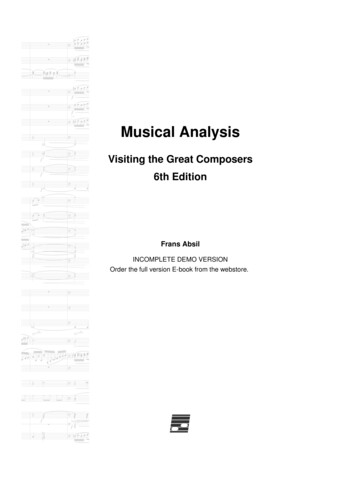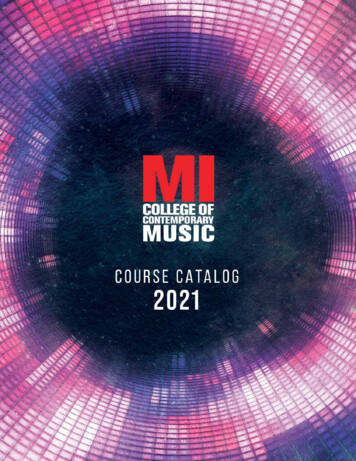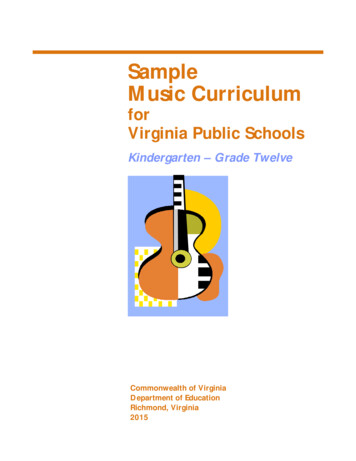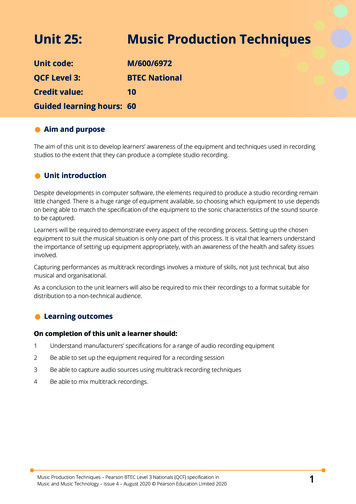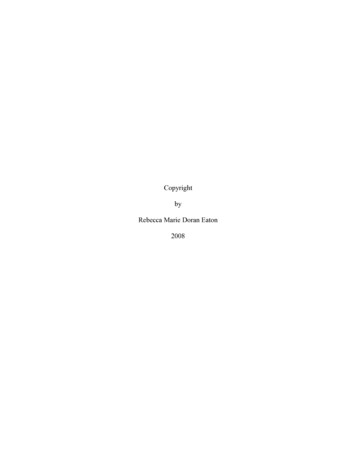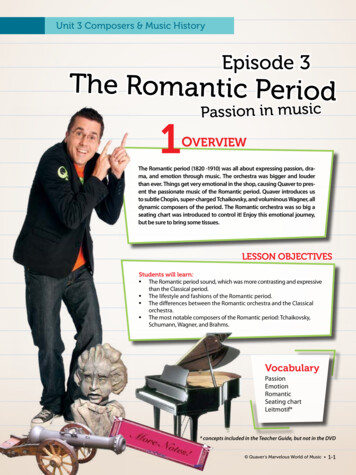
Transcription
Unit 3 Composers & Music HistoryEpisode 3The Romantic Period1Passion in musicOVERVIEWThe Romantic period (1820 -1910) was all about expressing passion, drama, and emotion through music. The orchestra was bigger and louderthan ever. Things get very emotional in the shop, causing Quaver to present the passionate music of the Romantic period. Quaver introduces usto subtle Chopin, super-charged Tchaikovsky, and voluminous Wagner, alldynamic composers of the period. The Romantic orchestra was so big aseating chart was introduced to control it! Enjoy this emotional journey,but be sure to bring some tissues.LESSON OBJECTIVESStudents will learn: The Romantic period sound, which was more contrasting and expressivethan the Classical period. The lifestyle and fashions of the Romantic period. The differences between the Romantic orchestra and the Classicalorchestra. The most notable composers of the Romantic period: Tchaikovsky,Schumann, Wagner, and Brahms.VocabularyPassionEmotionRomanticSeating chartLeitmotif** concepts included in the Teacher Guide, but not in the DVD Quaver’s Marvelous World of Music 1-1
Unit 3 Composers & Music HistoryMUSIC STANDARDS IN LESSON1: Singing alone and with others*4: Composing and arranging music6: Listening to, analyzing, and describing music8: Understanding the relationship between music and the other arts9: Understanding music in relation to history, style, and cultureComplete details at QuaverMusic.comKey ScenesWhat they teachMusicStandard1An emotional day in Quaver’sshopThe introduction compares the Baroque and Classicalperiods to the raw emotion and passion of the Romanticperiod.6, 92Great Romantic ComposersThe music and lives of Tchaikovsky, Schumann, Brahms,and Wagner are presented.8, 93Drawing on the emotionsof Chopin, Mussorgsky, andTchaikovskyBy listening to pieces by these composers, we feel theemotion of the period.6, 94Orchestral seating mayhemCarl Maria von Weber developed a seating plan for theorchestra. After the orchestra uses it, they play Tchaikovsky’s Piano Concerto in Bb.6, 95Song: Romantic Period withexcerpts by Brahms andSchumannThis song draws on melodies from the Romantic periodand emphasizes that this music was all about emotion.6, 92LESSON INTRO Introducing the episodeAsk students to write down a one-word response to this question: how are you feeling today?Write their responses for all to see. Ask them which responses describe emotions (happy, sad, excited, etc.) Circlethose responses, have them brainstorm other adjectives that describe emotions, and talk about each.Instruct them to come up with two notes to sing or play on an instrument to represent that emotion.You may have to take the lead in coaching the kind of emotion you want in the notes. Here are some examples:Angry – Da da (sung loudly and aggressively on the same note)Cheerful – La La (an octave between la and la, sung slowly)Surprised – Dun, DER (a very quiet first note and a very loud second note)Sad – Mmmm, Mmmm (two notes descending slowly)Create a sentence using angry, cheerful, surprised, and sad to which students can add their musical illustrations.1-2 QuaverMusic.com* concepts included in the Teacher Guide, but not in the DVD
Discussion Points 3The Romantic PeriodPLAY EPISODEName three composers of the Romantic period.Tchaikovsky, Schumann, Brahms, Chopin, and WagnerWhat were the dates of that period in music?1820-1910Use a word that describes the Romantic period.emotional, dramatic, passionateWhat changes were made to the orchestra during this period?more instruments were added, the trumpets added valves, theorchestra seating plan was establishedWhaMt iussaic Period?Historians classify music (andother forms of art) by bracketing years of stylistic similarity. Although opinions differ, these arethe most commonly 820)(1820-1910)(1870-1910)4CLASS ACTIVITIESExperience EmotionsTracks 1, 2, 3, 4 & 5Purpose: Interpreting emotion in musicPlay these tracks from Robert Schumann’s “Album for the Young” individually,and pause to allow students to give a name to the emotion heard in eachpiece. If desired, have students perform movements that represent eachemotion.Track 1Track 2Track 3Track 4Track 5Soldier’s MarchKnight RupertThe Happy FarmerThe Poor OrphanHunting SongDynamic DancesPurpose: Relating music and movementThe Romantic period was not music solely about love, but reallyrefers to the passionate nature ofthe music.Find a copy of Gustav Holst’s The Planets on the Internet and play the segment called Mars for students. Tell them that this song uses a wide assortment of dynamics – from pianissimo to fortissimo. Ask them to imagine theyare Martian dancers. Have them interpret the changes in dynamics of thepiece with body movements. Add to the fun of this activity with props. Howcan students vary their movements (line, shape, speed, direction, etc.)?Sound StoriesPurpose: How music can bring stories aliveDiscuss how dynamics and emotions in music help tell a story. Watch theanimated version of Dukas’s The Sorcerer’s Apprentice from Walt Disney’s“Fantasia.” Ask students to listen carefully for instruments that play particularcharacters or portray specific types of action. Disconnect the video cable of theDVD or cover the television monitor and play the song again. Periodically, askstudents how much they can tell of the story just by listening to the music.Note: You may wish to bring in soundtracks to other films recognizable to students. For example, you might play a flying sequence from a “Harry Potter”film or the animal stampede from “The Lion King.”1-3
Unit 3 Composers & Music HistoryMy Romantic Period StoryTracks 6, 7, 8, 9 & 10Purpose: Associating music and emotionListen to the following music pieces characteristic of the Romantic period. First, have students decide whatemotions they convey. (Remember, there are no right or wrong answers). Then piece the clips together intosome kind of story.Track 6 Mendelsohn’s a Midsummer Night’s Dream, Wedding MarchTrack 7 Chopin’s Nocturne Op. 9 No. 1Track 8 Berlioz’s Symphony Fantastic, 4th movementTrack 9 Schubert’s Unfinished SymphonyTrack 10 Liszt’s Faust Symphony, 3rd Movement (Mephistopheles)Divide students into five groups, assigning each one track. Each group creates a scene inspired by the music.After they’ve practiced, bring them together to perform their scenes sequentially.Tracks 3, 11, 12 & 13VIDEO REPLAYThe Romantic PeriodIWB 1Purpose: Listening to three piano miniatures by Brahms and SchumannListen again to Quaver singing The Romantic Period (Track 11), askingstudents to pay special attention to the excerpts of Romantic music.Now play the full versions of these piano miniatures: Schumann’s TheHappy Farmer (Track 3), Brahms’s Hungarian Dance No.7 (Track 12),and Schumann’s Dreaming (Track 13).Note: Piano miniatures are small, self-contained works that present one or two sentiments. Schubert described some of hiscompositions as “musical moments.”5Shop / Composer PortraitsIn the shop, students can click on portraits of Romantic period composers,Schumann and Brahms. When clicked,students try to complete a picturepuzzle of the composer whose music isplaying.IWB1-4Play activities on yourINTERACTIVE White Board QuaverMusic.comWEB ACTIVITIESMetro / Style VenuesStudents can travel via the Metroto the Classical Music Hall to learnmore about Baroque, Classical, andRomantic period music. Read thevenue book and listen to passionateRomanitc works by Hector Berliozand Camille Saint-Saens.
The Romantic Period6HOMEWORKSeating SanityWorksheet # 1Purpose: Learning the orchestra seating planPRINTPRINTWORKSHEETWORKSHEETRomantic composers kept adding more and more players to the orchestra. To make life easier forthe conductor, instruments were clustered with other members of the same instrument family.Using the worksheet and the word bank of instruments, have students label each section with theappropriate instrument family.Great Composers of the Romantic PeriodWorksheet # 2Purpose: Discovering important facts about Romantic period composersStudents can learn more about Romantic composers from the take-home page provided.Consider assigning them to learn the content for a quiz at the start of the next lesson. Thisdocument can be added to their other composer pages.Additional session omantic AssessmentTracks 14, 15, 16, 17 & 18Worksheet # 3Play five selections and have students identify on their worksheet which threeare characteristic of Romantic music.Track 14Track 15Track 16Track 17Track 18Tchaikovsky’s Piano Concerto No. 1, 1st Movement - RomanticWatercolor Skies - pop rockBizet’s Carmen, Overture - RomanticBach’s Brandenburg Concerto No.4,1st Movement- BaroqueWagner’s The Flying Dutchman, Overture - RomanticThen instruct students to answer the supplementary questionsprovided.1-5
Unit 3 Composers & Music History8CROSS-CURRICULUM ACTIVITIESDramatic ArtsHave students write down the name of several emotions they have identified in Romanticperiod music. Play a game of charades with them acting out the emotions and having theirfriends guess what they are portraying.PRINTPRINTWORKSHEETWORKSHEETArtTrack 19Worksheet # 4Give students this worksheet on a full-size piece of heavyweight paper.Have them decorate the fish with bright colors and patterns, then cutit out and glue to a popsicle stick. Listen to the Saint-Saëns’s Carnivalof the Animals, Aquarium (Track 19). Have students walk around theroom and move their fish to the direction (up or down) of the melody.For extra fun, blow bubbles during the contrasting section!Language ArtsThe Romantic period was a time of great children’s literature such as Treasure Island and Huckleberry Finn. Have students read a short exerpt from one of these stories (an exciting or scary scene)and create a Romantic-period composition, using different timbres and dynamics to represent theaction and emotion of the scene. Alternatively, have students listen to The Moldau from “Ma Vlast”(My Homeland) by Bedrich Smetana. The Moldau is a river that flows through the Czech Republic.Have students write a story about a trip down the Moldau and the things they picture as the musicrolls along.MaterialsNeeded- Heavyweight paper- Colored pencils orcrayons- Glue- Popsicle sticks1-6 QuaverMusic.com
9The Romantic PeriodDIGGING DEEPERWriter’s WorkshopPurpose: Connecting between music and storytellingAsk students to write a short story that includes a plot with several characters and some emotional encounters,instructing them to double-space their writing. Once completed, have them come up with musical elements theywould need to tell the story. What dynamics would be used at the beginning, middle, or end? What instrumentswould represent each character? Would the music sound happy, sad, angry, hopeful, or a combination of these?In the lines between their writing, have them add dynamics and musical ideas using a pencil of a different color.Listen for LeitmotifsTracks 20 & 21Purpose: Explaining leitmotifMany modern composers have borrowed musical ideas from the Romantic period. One such idea is Wagner’s useof the leitmotif, a repeated theme or melody representing a character, place, or idea. Listen to a piano version ofSiegfried’s Theme (Track 20). After students are familiar with this leitmotif, listen to Siegfried’s Funeral (Track21) where the theme can be heard in its orchestral version.Note: Watch your digital counter. The theme appears in the French Horn at 38 seconds and Trumpets at 1:12.Two modern examples of leitmotifs include John Williams’s score for Star Wars and Howard Shore’s score for TheLord of the Rings. Show students several scenes from one of these movies, or listen to the sound track. Ask studentsto take note of which characters, places, or ideas have their own musical idea. Then ask how those ideas are usedtogether to help tell the story.Note: Students may be able to hum you the answers without watching the movie!FeaturedInstrumentsTEACHER NOTESCymbalsPianoCannon1-7
Romantic Seating chart Leitmotif* assion in music Unit 3 Composers & Music History The Romantic period (1820 -1910) was all about expressing passion, dra-ma, and emotion through music. The orchestra was bigger and louder than ever. Things get very emotional in the shop, causing Quaver to pres - ent the
